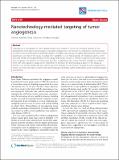Nanotechnology-mediated targeting of tumor angiogenesis
Author(s)
Banerjee, Deboshri; Harfouche, Rania; Sengupta, Shiladitya
Download2045-824X-3-3.pdf (703.7Kb)
PUBLISHER_CC
Publisher with Creative Commons License
Creative Commons Attribution
Terms of use
Metadata
Show full item recordAbstract
Abstract Angiogenesis is disregulated in many diseased states, most notably in cancer. An emerging strategy for the development of therapies targeting tumor-associated angiogenesis is to harness the potential of nanotechnology to improve the pharmacology of chemotherapeutics, including anti-angiogenic agents. Nanoparticles confer several advantages over that of free drugs, including their capability to carry high payloads of therapeutic agents, confer increased half-life and reduced toxicity to the drugs, and provide means for selective targeting of the tumor tissue and vasculature. The plethora of nanovectors available, in addition to the various methods available to combine them with anti-angiogenic drugs, allows researchers to fine-tune the pharmacological profile of the drugs ad infinitum. Use of nanovectors has also opened up novel avenues for non-invasive imaging of tumor angiogenesis. Herein, we review the types of nanovector and therapeutic/diagnostic agent combinations used in targeting tumor angiogenesis.
Date issued
2011-01Department
Harvard University--MIT Division of Health Sciences and TechnologyJournal
Vascular Cell
Publisher
BioMed Central Ltd
Citation
Vascular Cell. 2011 Jan 31;3(1):3
Version: Final published version